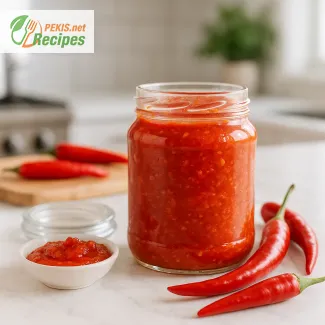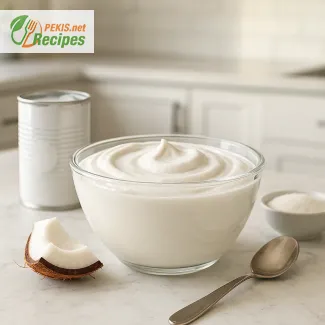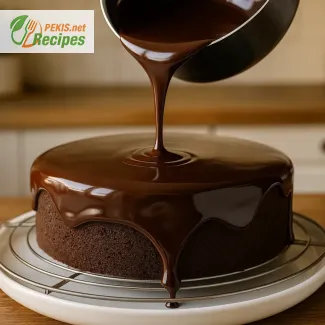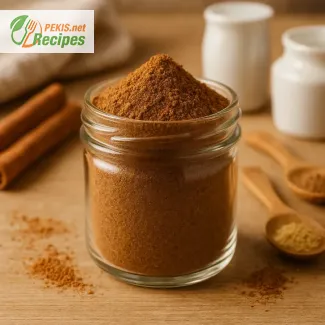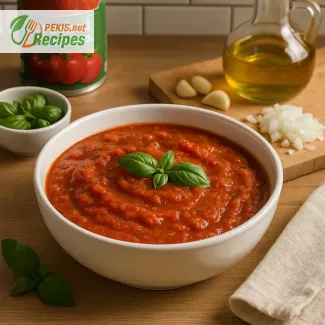Grilled steak with chimichurri sauce for 4, ready in 27 minutes (prep 15, cook 12). Juicy ribeye, smoky char, fresh parsley, oregano, garlic, and zesty vinegar-lemon dressing. Bold, balanced flavors with a vibrant green sauce that cuts through rich, tender beef.
PEKIS – professional chef and recipe developer with over 25 years of experience, specializing in European and international cuisine. Expert in premium meat preparation and traditional grilling techniques with a modern twist.
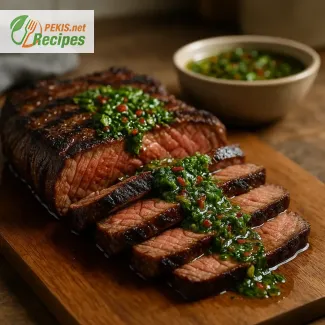
Mastering the Art of Grilled Steak with Vibrant Chimichurri
Juicy beef, smoky grill marks, and zesty herb sauce in perfect harmony
Sizzling over an open flame, grilled steak with chimichurri sauce delivers a captivating balance of flavors and textures. The meat’s smoky char and tender, juicy interior are elevated by the fresh, herb-forward punch of chimichurri, a classic South American sauce that pairs brilliantly with rich cuts of beef. Each bite combines savory depth with a bright, tangy finish, creating a dish that feels both indulgent and refreshing.
Originating in Argentina and Uruguay, chimichurri has been a staple condiment for grilled meats for centuries. Traditionally made with parsley, oregano, garlic, olive oil, vinegar, and chili flakes, it’s the embodiment of freshness. The sauce’s name is thought to come from Basque settlers or British soldiers in the region, blending linguistic influences into one memorable term. Today, it’s enjoyed worldwide, often accompanying expertly grilled steaks, where its acidity cuts through the meat’s richness, making each mouthful perfectly balanced.
The key to perfection lies in selecting a high-quality beef cut—ribeye, sirloin, or tenderloin are excellent choices—seasoned generously with salt and pepper to enhance natural flavors. The grill should be hot enough to create a caramelized crust while keeping the interior tender and moist. Once cooked to the desired doneness, the steak rests to allow juices to redistribute, ensuring every slice is succulent. Meanwhile, the chimichurri is freshly whisked to maintain its vibrant green hue and aromatic intensity.
Why you’ll love this recipe
- Bold contrast between smoky beef and fresh, zesty herbs
- Quick preparation with minimal ingredients
- Works for casual cookouts or elegant dinners
- Customizable heat level with chili flakes or fresh chili
- Perfect make-ahead sauce that keeps flavors bright
Storing and making ahead
Room temperature: Store cooked steak wrapped or in an airtight container for up to 2 days.
Freezing: Wrap portions individually and freeze for up to 2 months.
Reheating: Warm in a preheated oven at 150 °C (300 °F) for 8–10 minutes, or gently reheat on a grill to maintain texture. Chimichurri can be stored in the refrigerator for up to a week; bring to room temperature before serving.
Serving suggestions and variations
- Pair with roasted vegetables, baked potatoes, or grilled corn for a complete meal
- Swap parsley for cilantro for a different herbal profile
- Add a squeeze of fresh lime to chimichurri for extra brightness
- Serve thinly sliced steak over salads for a lighter option
- Top with extra chili flakes for a spicier kick
Cooking tips for perfect results
- Bring steak to room temperature before grilling for even cooking
- Pat meat dry before seasoning to ensure a better crust
- Rest the steak at least 5 minutes before slicing to preserve juices
- Use a meat thermometer for precise doneness control
- Prepare chimichurri at least 30 minutes ahead to allow flavors to meld
This combination of premium beef and authentic chimichurri sauce captures the spirit of open-fire cooking while remaining accessible enough for a weekday dinner. Its versatility and crowd-pleasing flavor make it an essential addition to any grilling repertoire.
- Take the ribeye steaks out of the refrigerator and let them rest at room temperature for about 30 minutes before cooking.
- Pat the steaks dry with paper towels to remove any excess moisture.
- Season both sides evenly with salt and freshly ground black pepper.
- Preheat the grill to high heat.
- In a medium bowl, combine finely chopped parsley, oregano, minced garlic, red chili flakes, red wine vinegar, olive oil, and lemon juice. Mix well until combined and set aside to allow the flavors to meld.
- Place the steaks on the grill and cook for 4–6 minutes per side, depending on the desired doneness. Use a meat thermometer for accuracy: 52 °C (125 °F) for rare, 57 °C (135 °F) for medium-rare, 63 °C (145 °F) for medium.
- Remove the steaks from the grill and let them rest on a cutting board for 5 minutes to retain their juices.
- Slice the steaks against the grain into thin strips.
- Drizzle generously with chimichurri sauce and serve immediately.
FAQ questionHow do I know when the steak is cooked perfectly?
Use a meat thermometer: 52 °C (125 °F) for rare, 57 °C (135 °F) for medium-rare, and 63 °C (145 °F) for medium. Always rest the steak for at least 5 minutes after grilling.
FAQ questionCan I make chimichurri in advance?
Yes, prepare it up to 24 hours before serving. Store in an airtight container in the fridge and bring to room temperature before use to preserve flavor and color.
FAQ questionWhich steak cuts work best for this recipe?
Ribeye, sirloin, tenderloin, or striploin are excellent choices for their balance of tenderness and flavor.
FAQ questionCan I grill the steak indoors?
Yes, use a cast-iron grill pan or a broiler if an outdoor grill isn’t available. Preheat well to get proper sear marks.
FAQ questionWhat can I serve alongside grilled steak with chimichurri?
Roasted vegetables, baked potatoes, grilled corn, or a fresh garden salad pair perfectly with the rich meat and tangy sauce.
FAQ questionIs chimichurri spicy?
Traditionally it has mild heat from chili flakes, but you can adjust the spice level by adding more or less chili or using fresh chili peppers.
FAQ questionCan I freeze cooked steak?
Yes, wrap portions individually and freeze for up to 2 months. Reheat gently at 150 °C (300 °F) for 8–10 minutes to maintain texture.
Elevating Grilled Steak with Fresh Chimichurri Flavors
Transforming a classic pairing into a personalized culinary highlight
A perfectly cooked grilled steak with chimichurri is already a celebration of flavor, but small adjustments can turn it from excellent to unforgettable. This combination of smoky, juicy beef and vibrant, herbaceous sauce has plenty of room for creative refinement, allowing you to tailor the dish to your taste, dietary needs, and presentation style.
Choosing the right cut and quality of beef
The foundation of an exceptional grilled steak lies in the quality of the beef. Opting for grass-fed ribeye, sirloin, or tenderloin delivers more depth of flavor and better texture. Thicker cuts, at least 3–4 cm (1.2–1.6 inch), allow for a beautiful sear while keeping the interior tender. If a leaner profile is desired, consider a cut like flank or flat iron, which benefits from a slightly shorter cooking time and a generous coating of chimichurri to keep it moist.
Enhancing the chimichurri sauce
The traditional chimichurri is made with parsley, oregano, garlic, red wine vinegar, olive oil, and chili flakes, but there’s room for personalization:
- Swap parsley for cilantro or combine the two for a layered herbal profile.
- Replace red wine vinegar with sherry vinegar or freshly squeezed lime juice for a different acidity balance.
- Add finely chopped shallots for subtle sweetness.
- For extra spice, incorporate fresh red chili peppers or a pinch of smoked paprika to echo the grill’s smokiness.
Mastering the grilling technique
Even with the right cut, improper grilling can compromise the result. High heat is essential for achieving a rich crust and sealing in juices. Patting the steak dry before seasoning ensures a stronger sear. Avoid moving the steak too frequently—allow it to cook undisturbed for the first few minutes on each side. Using a meat thermometer prevents overcooking: 52 °C (125 °F) for rare, 57 °C (135 °F) for medium-rare, 63 °C (145 °F) for medium. Resting the steak for at least 5 minutes is non-negotiable for juicy results.
Adding depth through marinades and rubs
While salt and pepper are enough for purists, introducing a dry rub with ground cumin, smoked paprika, or coriander can create an aromatic crust. Alternatively, a short marinade in olive oil, garlic, and herbs infuses the meat with flavor before grilling. If marinating, keep it under 2 hours for tender cuts to avoid overpowering the beef’s natural taste.
Common mistakes to avoid
- Overcrowding the grill: Leads to steaming instead of searing.
- Skipping the rest period: Causes juices to run out when slicing.
- Using cold steak straight from the fridge: Results in uneven cooking.
- Overcomplicating the sauce: Too many ingredients can mask chimichurri’s fresh character.
Health-conscious adjustments
For a lighter approach, use leaner beef cuts and reduce olive oil in the chimichurri. Replace part of the oil with water or vegetable broth for a lower-fat version without losing the sauce’s vibrancy. To reduce sodium, adjust the salt level and rely on fresh herbs and acid to bring brightness.
Serving and pairing ideas
- Serve over a bed of grilled seasonal vegetables for a colorful plate.
- Pair with quinoa or bulgur instead of potatoes for a whole-grain side.
- Use leftover steak slices for wraps or salads, topped with a drizzle of chimichurri.
Why homemade is better
Making this dish at home allows complete control over ingredient quality and cooking technique. Fresh herbs in chimichurri maintain their vibrant green color and punchy aroma, while freshly grilled steak avoids the overcooking and dryness often found in pre-prepared meals. You can also customize spice levels, acidity, and doneness to suit every guest.
For maximum flavor
Prepare the chimichurri at least 30 minutes before serving to let the flavors meld, but keep it at room temperature for the freshest taste. Just before serving, stir again to redistribute the herbs and oil. This ensures every bite of steak is coated in a sauce that’s as lively as the moment it was made.
Allergens present in the recipe:
- None of the common allergens such as gluten, dairy, nuts, soy, shellfish, or eggs are naturally present.
Tips for replacing allergenic ingredients and removing gluten:
- If serving with bread, use certified gluten-free bread to keep the dish gluten-free.
- For garlic-sensitive individuals, replace garlic with garlic-infused olive oil for flavor without the fresh garlic compounds.
Vitamins and minerals per serving (approximate):
- Vitamin C: 18 mg – supports immune system function and collagen production.
- Vitamin K: 165 µg – important for blood clotting and bone health.
- Iron: 4.2 mg – essential for oxygen transport in the blood.
- Potassium: 720 mg – helps maintain normal blood pressure and muscle function.
- Magnesium: 36 mg – supports muscle and nerve function.
Antioxidants per serving (approximate):
- Polyphenols: 120 mg – from parsley, oregano, and olive oil; may reduce inflammation.
- Flavonoids: 95 mg – contribute to cardiovascular protection.
- Carotenoids: 1.4 mg – support eye health and immune function.
